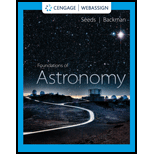
Why was the nebular hypothesis never fully accepted by astronomers of the day?
The reason behind the astronomers not fully accepting the nebular hypothesis.
Answer to Problem 1RQ
The reason behind the astronomers not fully accepting the nebular hypothesis is the missing explanation for the angular momentum of the planets.
Explanation of Solution
The most widely believed theory of the formation and evolution of the solar system is the nebular hypothesis but it has a few setbacks.
One of the major problems that the theory faced involved the distribution of the angular momentum between the planets and the Sun. The theory could not explain the fact that 99% of the angular momentum is possessed by the planets.
James Clerk Maxwell, a Scottish scientist, also criticized the theory. He said that if this theory is correct then, “the Moon must necessarily have carried off water and air from the watery and aerial parts of the Earth and must have an atmosphere". However, this is not true.
The astronomers did not fully accept the theory because of its inadequacies and it urged them to discover a substitution for the theory.
Therefore, the reason behind the astronomers not fully accepting the nebular hypothesis is the missing explanation for the angular momentum of the planets.
Want to see more full solutions like this?
Chapter 18 Solutions
EP WEBASSIGN FOR SEEDS/BACKMAN'S FOUNDA
- If the Orion Nebula is 8 pc in diameter and has a density of about 6.0 108 hydrogen atoms/m3, what is its total mass? (Notes: The volume of a sphere is 43r3; 1 pc = 3.1 1016 m; the mass of a hydrogen atom is 1.7 1027 kg.)arrow_forwardDescribe the solar nebula, and outline the sequence of events within the nebula that gave rise to the planetesimals.arrow_forwardDid hydrogen gas condense from the nebula as the nebula cooled? What about helium gas? How do you know?arrow_forward
 Foundations of Astronomy (MindTap Course List)PhysicsISBN:9781337399920Author:Michael A. Seeds, Dana BackmanPublisher:Cengage Learning
Foundations of Astronomy (MindTap Course List)PhysicsISBN:9781337399920Author:Michael A. Seeds, Dana BackmanPublisher:Cengage Learning
 Stars and Galaxies (MindTap Course List)PhysicsISBN:9781337399944Author:Michael A. SeedsPublisher:Cengage Learning
Stars and Galaxies (MindTap Course List)PhysicsISBN:9781337399944Author:Michael A. SeedsPublisher:Cengage Learning AstronomyPhysicsISBN:9781938168284Author:Andrew Fraknoi; David Morrison; Sidney C. WolffPublisher:OpenStax
AstronomyPhysicsISBN:9781938168284Author:Andrew Fraknoi; David Morrison; Sidney C. WolffPublisher:OpenStax
 Stars and GalaxiesPhysicsISBN:9781305120785Author:Michael A. Seeds, Dana BackmanPublisher:Cengage Learning
Stars and GalaxiesPhysicsISBN:9781305120785Author:Michael A. Seeds, Dana BackmanPublisher:Cengage Learning





